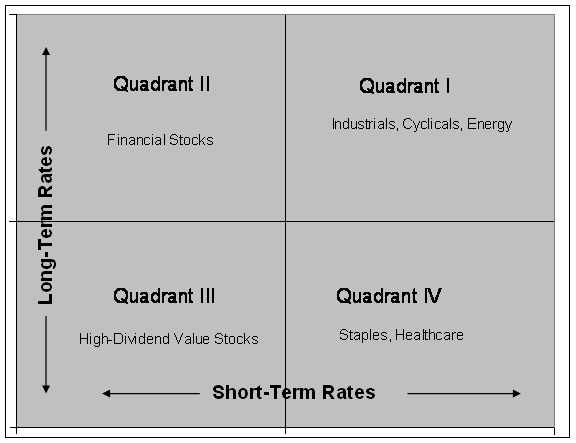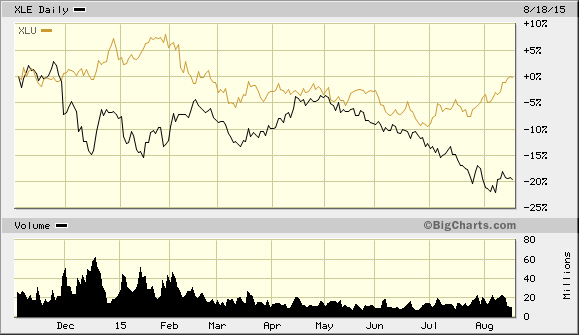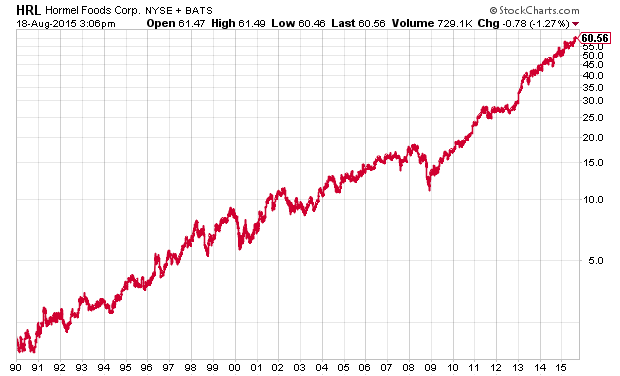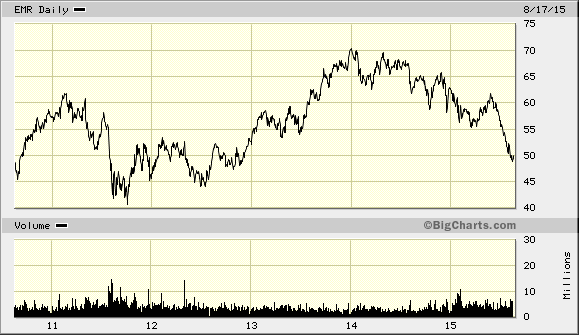Archive for August, 2015
-
The Market’s Battle: Energy or Utilities
Eddy Elfenbein, August 19th, 2015 at 12:24 pmNearly every day, it seems, the best and/or worst performing sectors of the market are Energy (XLE) and Utilities (XLU).
This tells us something. From my world-famous “Elfenbein Theory,” the market is oscillating on an axis between Quadrants I and III. Here’s my chart again.
It’s like a boat where all the passengers go right from one side of the ship to the other. That’s what the daily action has been like. Here’s a look at how the XLE and XLU are behaving:
They’re almost like two magnets. Recently, Utes have been winning. What’s happening is that the market is focused on interest rates. A rate increase shores up the dollar and will lower commodity prices. This summer has been a disaster for commodity prices.
-
Hormel Foods Beats and Raises
Eddy Elfenbein, August 19th, 2015 at 7:52 amHormel Foods (HRL) reported fiscal third earnings of 56 cents per share. That was one penny better than expectations. The company also raised their full-year guidance to $2.57 to $2.63 per share. The previous range was $2.50 to $2.60 per share. The new guidance represents earnings growth of 15% to 18% over last year.
“Our balanced business model prevailed once again this quarter, as we were able to overcome the significant challenge of avian influenza in our Jennie-O Turkey Store segment to deliver record earnings and volume sales,” said Jeffrey M. Ettinger, chairman of the board, president and chief executive officer. “Grocery Products drove earnings growth with favorable input costs and increased sales of HORMEL® chili and SKIPPY® peanut butter. Specialty Foods also delivered excellent results, as the team continues to increase sales of MUSCLE MILK® protein nutrition products, and improve the cost structure and synergies between our CytoSport and Century Foods businesses. Revenues were down for the quarter, impacted by lower pricing due to declining pork markets affecting our Refrigerated Foods and International segments, and the loss of sales related to avian influenza in the Jennie-O Turkey Store segment.
-
Long-Term Chart of Hormel Foods
Eddy Elfenbein, August 18th, 2015 at 3:09 pmDull is good. Look at the Hormel Foods (HRL) log chart since 1990.
In 2008, the stock fell 42%, but it looks like a minor setback in this chart.
-
The Volition Bias
Eddy Elfenbein, August 18th, 2015 at 1:50 pmPlease indulge me for a bit while I offer a somewhat rambling post. Barry Ritholtz often writes about cognitive biases and how they affect our investment decisions. This is especially important in financial matters. There are plenty of otherwise rational people who think a coin that’s gone heads the last four times has a high chance of going tails because, well, tails is due. What’s especially interesting is how these biases seep into our thinking without our realizing it.
I’d like to offer another bias to the literature: seeing the world of finance as being unduly under the control of people or institutions. Let’s call it the “Volition Bias.” I see this every day. All sorts of commentators talk about the role of the Federal Reserve or Goldman Sachs or high-frequency traders.
The disquieting reality is that no one’s in charge. The market just is. It’s not easy to grasp this point, but it’s true. The market is controlled by the market. Obviously, some groups are certainly influential, but what’s lost sight of is that they’re merely players in the game just like everyone else. Too much market commentary is simply cynicism masquerading as wisdom.
This extends to the role of finance itself, and I say this as a finance person. Think of the economy as having two parts. One part is where people make stuff. The other is where people in suits trade colored pieces of paper. That’s the finance side. While finance is critical, it’s always subservient to the real economy. Finance helps push the economy along. The bias I often see is people mistaking the financial economy for the real economy.
Let me give you an example. (As usual, these are generalities, but broad enough to be important.) When a company runs into financial trouble, it’s usually the result of operational troubles. The financial troubles are merely a manifestation of their operational issues. They’re not bad because they’re in too much debt. They’re in too much debt because they’re bad. It’s certainly possible for a healthy company to be done in by financial mismanagement, but that takes some effort.
Put it this way. If there’s news of a group of people meeting in a room, it’s probably not that important to you as an investor. Is an OPEC meeting important? Of course. In the short term. But they’re merely reacting to the same variables we all see. A Fed meeting is also important. But the Fed isn’t, despite what you may have heard, making the weaker argument the stronger. They’re only trying to manage monetary policy. (I didn’t say they were good at it.)
I’m sure there are cases of price manipulation that we never know about. But that can only last for so long. In the end, the market is controlled by the market. The truly important events for investors are the decisions made by a large group of consumers. People want the best product or service at the best price. Find that, and all the financial issues will follow.
-
Morning News: August 18, 2015
Eddy Elfenbein, August 18th, 2015 at 7:12 amEmerging Stocks Decline as Thai Bomb Adds to China, Fed Concerns
German Lawmakers Debate Greek Bailout, Merkel Faces Rebellion
Putin Revives Soviet Deal of Pretend-Work-and-Pay to Hide Crisis
China Turned to Risky Devaluation as Export Machine Stalled
Sterling Rallies After UK Inflation Beats Expectations
World’s Biggest Currency Trade Is Stuck in a Fed-Induced Rut
Methane Leaks in Natural-Gas Supply Chain Far Exceed Estimates, Study Says
Jeff Bezos and Amazon Employees Join Debate Over Its Culture
Wal-Mart Cuts Outlook on Investments in Wages, E-Commerce
Recovery in U.S. Housing Market Drives Home Depot Sales Beat
Zulily Is Lost Up The Amazon With Latest Deal
Illumina, Warburg Pincus Form Consumer-Genomics Startup Helix
Fish Farming Becomes Bigger Business Than the Open Sea
Jeff Carter: The Millennials Are Coming, The Millennials Are Coming
Joshua Brown: Five Things I Learned from Carol Loomis Today
Be sure to follow me on Twitter.
-
New High Today for the Buy List
Eddy Elfenbein, August 17th, 2015 at 4:11 pmWe had a few new highs today for our Buy List. Fiserv (FISV), Hormel Foods (HRL), Snap-on (SNA) and Stryker (SYK) all touched new 52-week highs today. Also, the Buy List closed a new high for the year with a 7.89% YTD gain.
-
What’s Up with Emerson Electric?
Eddy Elfenbein, August 17th, 2015 at 11:27 amI caution investors to try to avoid buying a stock with a P/E Ratio of 10 and hoping it doubles to 20. A better strategy is to look for a stock where the E — the earnings — can triple in a decade.
I think value investors too often overemphasize the value portion of the equation at the expense of growth. The value side can really be summed as “don’t do anything crazy.” Outside that, I don’t worry too much about value. And I never try to short based on value.
Lately, I’ve been looking at the stock of Emerson Electric (EMR). Emerson has long been one of those stalwart blue chip stocks. They’ve raised their dividend every year since the Eisenhower administration.
But the shares have come under hard times recently. EMR dropped from a high of $62.75 in May to a low of $47.83 last week. It’s currently just below $50 per share. As a domestic manufacturer, the strong dollar has hit Emerson hard. The last earnings report was a complete dud:
Given that little change is expected in market conditions for the remainder of the year, Emerson again slashed guidance. The company now projects $3.97 to $4.07 in per-share earnings for the business year ending in September, down from its last estimate of $4.17 to $4.32 a share. That range includes a gain of 77 cents a share stemming from its power-transmissions divestiture.
The company, which had said it would accelerate restructuring plans, said full-year restructuring is now expected to be between $160 million and $180 million.
In all for the June quarter, Emerson earned $564 million, or 84 cents a share, down from $728 million, or $1.03 a share, a year earlier.
Revenue slid 13% to $5.5 billion. Stripping out currency effects and the impacts of divestitures, sales fell 5%, the company said.
Ouch!
But there’s an upside (you were probably wondering). Emerson is planning some big changes. In June, they said they’ll spinoff their network-power business. The company’s previous strategy was to go into network power in a big way. To put it lightly, that was a flop. Fortunately, the company is trying to undo the problem. Emerson is also considering selling off part of their industrial-automation group.
I like these moves, and I’m impressed when a good company recognizes the bad moves they’ve made. The slimmed-down Emerson could be a very good buy. It’s too early to say just yet, but EMR is a stock to watch.
-
Morning News: August 17, 2015
Eddy Elfenbein, August 17th, 2015 at 6:37 amEuropean Stocks Bounce Back From Worst Week in Six
Tsipras Likely to Call Confidence Vote After Party Revolt
Merkel Says She’s Confident IMF Will Join Greek Bailout
Japan Says Its Economy Contracted in Second Quarter
Crude Oil Futures Down on Weak Asian Cues
U.S. Industrial Production Ratchets Up in July
Morgan Stanley’s Fragile Five Swells to Troubled 10 in Selloff
IndiGo Finalizes $26.5 Billion Purchase of 250 New Airbus Jets
LG Display to Focus Investment on OLED in Next-Generation Push
Cargill Buys Norwegian Fish-Feed Producer EWOS for $1.5 billion
Samsung Slumps to 10-Month Low on Disappointment With Phones
Disney Bulks Up Theme Parks as Universal Gains Ground
Jeff Bezos Says He Doesn’t Recognise ‘Soulless and Dystopian’ Portrayal of Amazon
Howard Lindzon: EVERYONE Should Angel Invest….and Robinhood Launches Android App
Be sure to follow me on Twitter.
-
10-Year TIPs Yield and Stock Returns
Eddy Elfenbein, August 14th, 2015 at 12:52 pmI’ve been crunching the numbers on stock returns and the 10-year TIPs yield.
Intuitively, this relationship makes sense. TIPs are a decent measure of expected bond values, so the lower their yields, the better the return ought to be for stocks.
One problem is that there’s not a lot of data. I went to FRED and took all 10-year TIPs data, which only goes back to 2003. I then compared it with the Wilshire 5,000 Total Return Index. I wish we had more data. In time, that will come.
I compared the TIPs yield on one day and with the equity return the following day. I divided the TIPs into eight different buckets. Here’s what I got, listed by ascending TIP yield.




 Eddy Elfenbein is a Washington, DC-based speaker, portfolio manager and editor of the blog Crossing Wall Street. His
Eddy Elfenbein is a Washington, DC-based speaker, portfolio manager and editor of the blog Crossing Wall Street. His